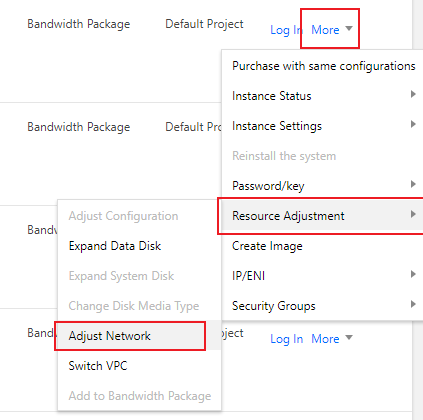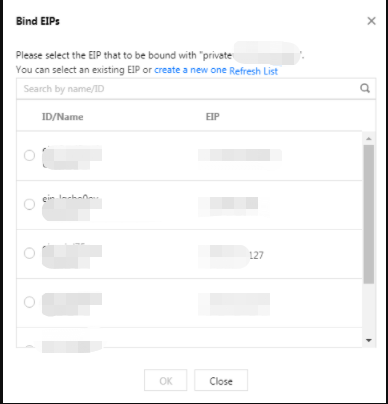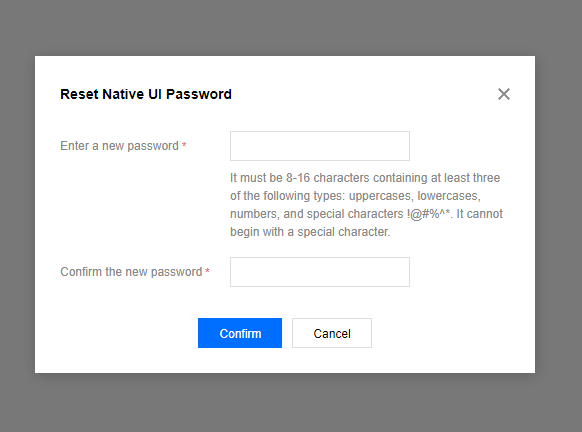WebUI 访问
最后更新时间:2023-12-27 11:10:24
功能介绍
软件 WebUI 入口功能是 EMR 提供的组件原生 UI 访问能力,通过 Master 节点的外网 IP(建议及时配置安全策略)可以快捷访问组件原生 UI。如果集群内网与企业网络互通,可关闭该外网 IP,直接通过内网访问组件原生 UI。
查看 WebUI 访问地址
1. 登录 EMR 控制台,在集群列表中单击对应的集群 ID/名称进入集群详情页。
2. 在集群详情页中单击集群服务,然后单击对应的组件卡页下方 WebUI 地址即可访问。
访问地址需要进行身份验证,用户名为 root,默认密码为创建集群时输入的密码。如果需要修改密码,可以在此页面中单击重置 WebUI 密码进行修改。
访问内网 WebUI
集群创建时,如果没有勾选开启集群 Master 节点公网,将不能通过组件管理页面的原生 WebUI 访问地址进入相关组件的 WebUI 界面。在内网环境中通过浏览器访问组件 WebUI。各组件原生 WebUI 链接如下表所示:
组件名 | 链接 |
HDFS UI | http://{集群内网ip}:4008 |
YARN UI | http://{集群内网ip}:5004 |
HBASE UI | http://{集群内网ip}:6001 |
HIVE UI | http://{集群内网ip}:7003 |
HUE UI | http://{集群内网ip}:13000 |
RANGER UI | http://{集群内网ip}:6080 |
STROM UI | http://{集群内网ip}:15001 |
OOZIE UI | http://{集群内网ip}:12000 |
GANGLIA UI | http://{集群内网ip}:1800 |
PRESTO UI | http://{集群内网ip}:9000 |
ALLUXIO UI | http://{集群内网ip}:19999 |
如需在集群创建后通过公网访问组件 WebUI,可以给主 Master 节点绑定一个弹性公网 IP(EIP)实现。绑定 EIP 操作如下:
1. 登录 EMR 控制台,在集群列表中单击对应的集群 ID/名称进入集群详情页,然后在集群资源 > 资源管理中选择需要绑定弹性公网 IP 的 Master 节点,单击资源名称/资源 ID 进入云服务器控制台。


2. 调整 CVM 实例的网络带宽设置,保证需要绑定 EIP 的 CVM 实例带宽不为0,否则会无法连接相应节点。
在云服务器控制台 CVM 实例列表中选择对应实例的更多 > 资源调整 > 调整网络。


3. 单击 CVM 实例的实例 ID 进入实例基本信息页面,并切换到弹性网卡页面。


4. 单击绑定,为当前 CVM 实例绑定一个已有的 EIP 或创建一个新的 EIP。


5. 检查 CVM 实例是否可以通过公网访问。
6. 可以通过 ping 或 ssh 命令检查 EIP 是否生效,要确保安全组入站规则对 ICMP 和22端口开放。访问组件原生 WebUI。
EMR-V1.3.1、EMR-V2.0.1、EMR-V2.1.0、EMR-V3.00 已支持 Apache Knox,默认在公网访问组件原生 WebUI 经过 Knox,各组件详细 UI 链接和 Knox 使用,请参考 Knox 指引。
说明
重置 WebUI 密码
访问地址需要进行身份验证,用户名为 root,默认密码为创建集群时输入的密码,如需重置 WebUI 密码可以通过以下操作实现。
1. 登录 EMR 控制台,在集群列表中单击对应的集群 ID/名称进入集群详情页。
2. 在集群详情页中单击集群服务,然后单击左上角重置 WebUI 密码进行密码重置。
注意
密码要求:8-16个字符,至少包含大写字母、小写字母、数字和特殊字符(!@#%^*)中的三种,其中第一个字符不能为特殊字符。
已安装 OpenLDAP 的集群(EMR-V2.6.0 和 EMR-V3.2.1 以后产品版本),密码调整只能在用户管理页面进行管理。如需重置 WebUI 密码,请在用户管理页面,使用新建用户功能进行操作。

文档反馈

